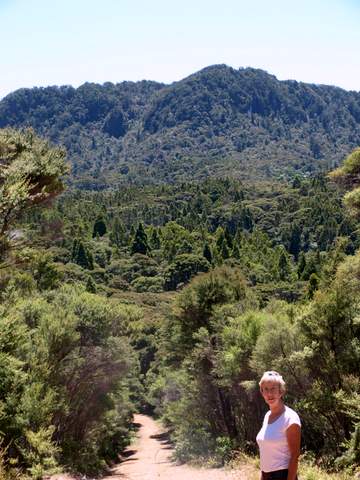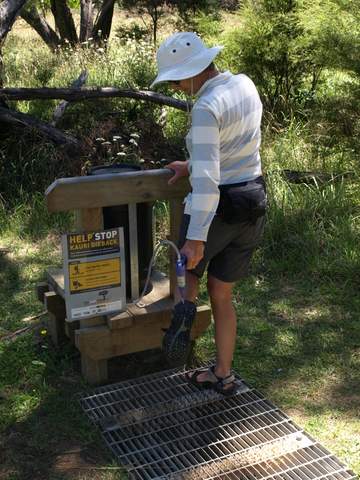Killling the kauris

VulcanSpirit
Richard & Alison Brunstrom
Sun 2 Mar 2014 06:46
|
If an avid and conscientious reader of this Blog
you may recall our visit to the groves of iconic giant kauris in
Northland. The NZ kauri Agathis australis, distantly related to the
monkey puzzle tree, can grow to be one of the world's biggest trees by
volume - in fact the largest one known may have been the very biggest tree in
the world but it was dead of natural causes by 1850. Here is one of the largest
remaining kauri, with Alison just visible in the foliage below the bottom of the
trunk for scale:
 Kauri forest covered much of North Island NZ when
European arrived but it proved to be an excellent timber for shipbuilding and
was mercilessly exploited - remarkably the first Royal Navy ship laden with
kauri spars left NZ for the UK before the close of the eighteenth century, only
a few years after Cook's discovery of the country. Only small fragmentary
remnants of these vast forests have survived to the modern era.
Kauri survived longer on some of the larger offshore islands, most notably Great
Barrier. However in 1925 the Kauri Timber Company (KTC) set out to mill
every single tree on the island with a diameter greater than 300mm - a mere
sapling by kauri standards. GBI is a steeply mountainous island and this was a
huge industrial undertaking requiring the construction of NZ's biggest tramway
system with seven steam powered inclines. Even this was not enough in the
steepest areas where water and gravity were used. Here is the remains
of a kauri dam, now a national monument:
 This is a huge structure whose scale is not
apparent in the picture. The dam held water back. Kauri logs were dragged to the
temporary lake by oxen or horse. Eventually a trigger was pulled and the dam
gate opened shooting the logs down to the sea.The gate (vertical planks in
the centre) shown in the dam above is about 3m high. Water ponded back up
to the level of the top horizontal trunk which was a spillway - so a total
height of well over ten metres. There were three such dams on this stream -
triggeing them must have been quite a sight.
The KTC was extremely "successful". In less than
two decades a forest that had taken millenia to develop had been utterly
destroyed. By 1941 nearly every single kauri had gone from GBI. Just a few
remained on the highest tops when reason prevailed and logging was stopped. Tens
of thousands of kauri had gone. But not for ever. The island is now protected,
and regeneration of the kauri forest is a high priority. Luckily the land was
not farmed, merely cleared of kauri and abandoned. This has allowed kauri
seedlings to germinate naturally, and uncountable thousands of them are
sprouting up. Here they are, just beginning to poke their pointed heads out of
the manuka scrub:
 Here is another baby, up close. Note that the
growth pattern is entirely different to the adult tree (a common feature in NZ),
with a top spike and no giant crown:
 So there is some hope that given a thousand or two
years, there may be a new kauri forest here. Or sadly there may not. Tragically
no sooner had the felling stopped than the few remaining kauri started dying
from kauri dieback disease. This is caused by a
fungus which kills nearly every tree that it infects. It seems to
have evolved to attack kauri only very recently, and its effect on kauri is
greatly exacerbated by human activity - its spores are readily carried by soil
movement on footwear, mountain bikes and machinery, and shallow kauri roots are
very prone to mechanical damage, even by trampling, allowing infection. There is
as yet no known cure. So the entrance to all protected kauri areas is guarded by
a chemical footwash to try to kill the fungal spores:
 This disease is a real tragedy, and the outcome is
far from certain. Keep your fingers crossed.
|